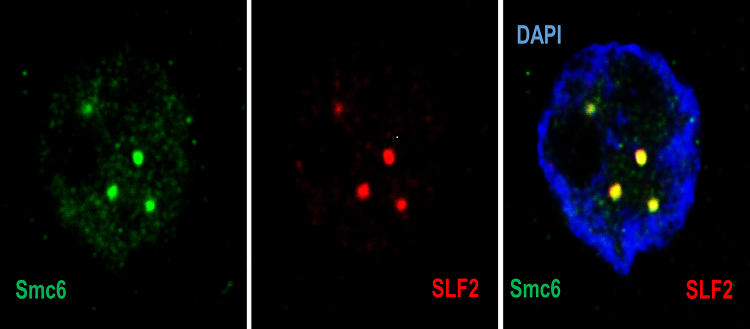Reviewed by Danielle Ellis, B.Sc.Oct 5 2022
One of the most severe and prevalent viral diseases is caused by the hepatitis B virus (HBV). It targets the liver cells after being transmitted by bodily fluids. Severe complications from the chronic form of the disease can develop, such as cirrhosis and liver cancer.
 Confocal microscopy images showing in the cell nucleus (blue), the recruitment of Smc5/6 (green) by SLF2 (red) into PML bodies. Image Credit: © UNIGE-Laboratory of Professor Michel Strubin - Regulation of hepatitis B virus gene expression-Department of Microbiology and Molecular Medicine.
Confocal microscopy images showing in the cell nucleus (blue), the recruitment of Smc5/6 (green) by SLF2 (red) into PML bodies. Image Credit: © UNIGE-Laboratory of Professor Michel Strubin - Regulation of hepatitis B virus gene expression-Department of Microbiology and Molecular Medicine.
The chronic version of the illness has no proven cure; immunization is the only effective means of prevention. A team from the University of Geneva (UNIGE) has unraveled the precise operation of this defensive mechanism after finding a crucial protein complex that is active when our body is infected by the virus, paving the path for novel treatment targets.
The Nature Structural and Molecular Biology journal publishes these findings.

Image Credit: Kateryna Kon/Shutterstock.com
The most prevalent type of hepatitis is hepatitis B. The hepatitis B virus is the basis of the viral disease. Mostly, it is spread through blood or sexual contact. It can spread up to 100 times faster than HIV. This virus infects the liver cells, resulting in a brief inflammation of the liver that could progress to a chronic infection.
Severe diseases like cirrhosis or liver cancer can result from this. According to estimates, this disease claims over one million lives each year throughout the world. Chronic hepatitis B does not have a permanent cure. It can only be avoided by receiving a vaccination before the disease manifests.
A UNIGE team led by Michel Strubin, an Associate Professor in the Department of Microbiology and Molecular Medicine and in the Geneva Centre for Inflammation Research at the UNIGE Faculty of Medicine, discovered a mechanism for this disease in 2016 that is essential for understanding: when the immune system defends itself against it, a complex, or interdependent set, of six proteins called SMC5/6, present in the cells, detects the viral DNA and blocks it.
The virus subsequently responds by producing the X protein, a unique protein. SMC5/6 is destroyed by this protein as it enters the cell, rendering it incapable of performing its sentinel function.
A three-step mechanism
The antiviral role of SMC5/6 was unknown prior to this finding. It was only found to be a crucial complex for maintaining the structural integrity of our chromosomes. Now, Michel Strubin’s group achieved a new breakthrough.
In a recent study, the UNIGE researchers determined the three processes and the precise proteins needed for SMC5/6 to perform its antiviral function in association with the American pharmaceutical company Gilead Sciences.
In the first step, a protein of the SMC5/6 complex detects the virus’ DNA and traps it. Then, a second protein of the complex— SLF2—takes the trapped DNA of the virus into a sub-compartment of the nucleus of the attacked cell, called the PML body. A third protein—Nse2—then comes into play and inhibits the virus’ chromosome.”
Fabien Abdul, Study First Author and Senior Research and Teaching Assistant, Department of Microbiology and Molecular Medicine, Faculty of Medicine, University of Geneva
The researchers also sought to determine if other “members” of the SMC family were able to attach to hepatitis B viral DNA since SMC is a large family of protein complexes.
Towards new therapeutic targets
The research team used in vitro cell cultures to get these results.
We used molecular biology techniques and more specifically genetic scissors called CRISPR-Cas9. This tool allowed us to cut the DNA strands within the cells and thus delete or modify the gene coding for each protein constituting the SMC5/6 complex. Thanks to this technique, we were able to make one or other of the proteins disappear and thus understand their respective functions within the complex.”
Michel Strubin, Study Last Author and Associate Professor, Department of Microbiology and Molecular Medicine, University of Geneva
These observations could be used to establish the three phases of the antiviral process.
This finding helps to comprehend the complex’s mechanism of action during its antiviral activity. Thus, it might open the door to the discovery of new therapeutic targets to fight the hepatitis B virus.
The next stage of research will consist of better deciphering the mechanism of inhibition of the virus in the sub-compartment of the cell nucleus.”
Aurélie Diman, Postdoctoral Researcher, University of Geneva
To fully comprehend how hepatitis B fights the antiviral activity of the cellular SMC5/6, a study on the X protein, whose function was discovered by the UNIGE researchers in 2016, will also need to be done.
Source:
Journal reference:
Abdul, F., et al. (2022). Smc5/6 silences episomal transcription by a three-step function. Nature Structural and Molecular Biology. doi.org/10.1038/s41594-022-00829-0